| |
|
 |
 |

|
Santa Maria Novella in Florence [0]
|
|
![Toacana ] Galleria di immagini](/titels/albump.gif) |
|
| |
 |
|
|
| |
|
Florence | Basilica of Santa Maria Novella |
|
|
|
| |
|
In 1219 twelve Dominican friars led by Fra Giovanni da Salerno came from Bologna and two years later obtained as their Florentine dwelling the church of Santa Maria delle Vigne, outside the city walls.
The much larger church we see today was begun in 1279 to a design by two Dominican converses, Fra Sisto and Fra Ristoro, and was almost concluded with its adjacent convent by the middle of the 14th century.
Its internal structure resembles that of Cistercian gothic churches, the nave being separated from the aisles by wide bays and covered with gothic vaulting. Among the first works of art to reach the church was Duccio’s Maestà (1285), known as the ‘Rucellai Madonna’, which is now in the Uffizi. The Crucifix documented inside the church in 1312 was painted by the young Giotto.
The major 14th-century decorative schemes that have come down to us date from the years after the Plague of 1348. In the left transept, between 1350 and 1357, Nardo di Cione frescoed the walls of the Strozzi Chapel with the Last Judgement, Hell, and Paradise; the stained glass is also by Nardo. On the altar the panel, signed and dated 1357, with Christ giving the Keys to St Peter and a book to St Thomas Aquinas, with the Madonna, St John the Baptist and other Saints, and its predella, are the work of Nardo’s brother, Andrea di Cione, known as Orcagna (signed and dated 1357). Between 1367 and 1369 Andrea di Bonaiuto frescoed the convent’s chapter room, known as the ‘Spanish Chapel’: on the altar wall are the scenes of the Passion, Crucifixion and Descent of Christ into Limbo; on the entrance wall are Scenes from the life and miracles of St Peter Martyr; the right-hand wall has an Allegory of the Church Militant and Triumphant, and the left-hand wall the Triumph of St Thomas Aquinas. The segments of the vault have the Resurrection, Ascension, Barque of St Peter and Pentecost.
|
![Leopoldo Alinari, Piazza Santa Maria Novella, Firenze, ca. 1854 [Fratelli Alinari, Fotografi Firenze, Presso Luigi Bardo]
</p></td>
</tr>
<tr>
<td align=](https://lh3.googleusercontent.com/pw/AP1GczPkYVHWzmlyMdYhvX0kmxHpL857Jk7CvkvlPIZbFgsX-kAfY7jyAvMeHP1AwalrOR9BkNmDCZjgIcQ-jBnjwJOHwRpkt1kIzejWx43pi2MSHPLzuylI=w1600-h1200-p-k)
|
Leopoldo Alinari, Piazza Santa Maria Novella, Florence. Large-format salt print. 26,5 x 34,2 cm. Number 42 in the negative in lower right, with photographer's blindstamp Fratelli Alinari, Fotografi Firenze, Presso Luigi Bardo [Alinari Archives, Firenze]
|
The renaissance style was introduced into Santa Maria Novella with Masaccio’s celebrated fresco of the Trinity with the Madonna, St John the Evangelist and two patrons (1427).[1] Filippo Brunelleschi’s wooden Crucifix in the Gondi Chapel was intended, according to Vasari, as a response to the vigorous naturalism of Donatello’s version in Santa Croce. In 1439 Santa Maria Novella was the scene of the Council of Florence, convoked to bring about the reunion of the Greek and Latin Churches. Pope Eugenius IV stayed for many months, and it was a brilliant moment in the convent’s history. Subsequently Paolo Uccello painted Scenes from the life of Noah in the Green Cloister, and Leon Battista Alberti completed the church’s façade in 1470. Towards the end of the 15th century two important fresco cycles were painted for the church by Domenico Ghirlandaio and Filippino Lippi.
In 1485 Giovanni Tornabuoni commissioned from Ghirlandaio frescoes and stained glass for the chapel of the high altar, with Scenes from the life of the Virgin and Scenes from the life of the Baptist, filled with figures from the upper-class Florentine society of the time.
Quite different was the chapel of Filippo Strozzi, decorated with frescoes and stained glass by Filippino Lippi and finished in 1502. The side walls illustrate scenes from the Life of St Philip and the Life of St John the Evangelist, while on the end wall the chiaroscuro painting provides a monumental setting for the tomb of Filippo Strozzi by Benedeto da Maiano (1495). In 1565 Santa Maria Novella was subjected to a programme of restoration ordered by Duke Cosimo I de’ Medici and directed by Giorgio Vasari.
Part of this scheme was the Gaddi Chapel, rebuilt by Giovanni Antonio Dosio in 1577. It was frescoed by Alessandro Allori with scenes from the Life of St Jerome and Virtues, and has an altarpiece by Agnolo Bronzino of Jesus raising the daughter of Jairus.
Among the most important pictorial witnesses between the late 16th and early 17th century is the fresco cycle in the Great Cloister of Santa Maria Novella, with scenes from the Lives of Christ and the Dominican Saints. The artists included Santi di Tito, Alessandro Allori, Cigoli, and others. From the south side of the Cloister one gained access to the old pharmacy and perfumery, which is today reached from Via della Scala.
|

|
Bonaiuti Andrea, Trionfo di san Tommaso d'Aquino, cappellone degli Spagnoli, Chiesa di S. Maria Novella, Firenze[Brogi — Firenze. Chiesa di S. M. Novella. Cappella degli Spagnoli; XVI secolo — insieme] [1]
|
The Cloisters
The first cloister on the right of the doorway is the so-called Chiostro verde (Green cloister) with strong yet harmonious proportions. It takes its name from the frescoes originally painted in "green clay" by many artists of early 15th century including Paolo Uccello (1397-1475), one of the greatest Florentine Renaissance masters, who painted here some of his best works like the Flood and the Sacrifice of Noah.[3]
The cloister gives access to the Refectory (and from here to the Large Cloister decorated at the end of the 16th century) and to the Cappellone degli Spagnoli. In the 16th century this was the chapter house and was given this name because of meetings held in this location by the Spanish followers of Eleonora da Toledo, the wife of Cosimo I. This large section of the building still preserves the complex frescoes by Andrea di Bonaiuto (mid-14th century), which exalt the work of the Dominicans, to whom the church belonged. The fresco representing the Church militant features the cathedral in the background or rather the original project of Arnolfo for the Cathedral of Florence.
The Chiostro verde also gives access to the Chiostrino dei morti and the Strozzi Chapel, decorated with 14th century frescoes. |
|
|
|
| |
|
The Dominican monks, Sisto and Ristoro, are traditionally credited with the planning and construction of the Church of Santa Maria Novella in Florence. The plan of the building, a Latin cross with square chapels jutting out from the east side of the transept, was used for Franciscan models. The dynamic concept differs, from the slender cross vaults to acute pointed arches separating the nave, but with a greater spatial unity.
|
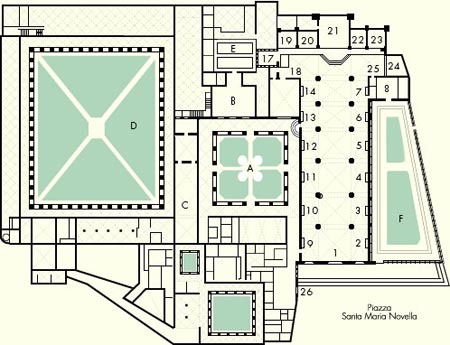
|
1. Facade (Giovan Battista Alberti)
2. Martyrdom of Saint Laurence (Girolamo Macchietti)
3. Adoration of the Shepherds (Giovan Battista Naldini)
4. Presentation in the temple (Giovan Battista Naldini)
5. Descent from the Cross (Giovan Battista Naldini)
6. The Predictions of Vincent Ferrer (Jacopo Coppi del Meglio)
7. Jacopo Ligozzi
8. Cappella della Pura (Wooden crucifix by Baccio da Montelupo)
9. Resurrection of Lazarus (Santi di Tito)
10. The Good Samaritan (Alessandro Allori)
11. The Holy Trinity (Masaccio)
12. Madonna of the Rosary ((Giorgio Vasari)
13. Altar: Poccetti
14. San Giacinto (Alessandro Allori)
15. Pulpit-Filippo Brunelleschi / Buggiano
16. Sacresty
17. Chapel Strozzi di Mantova (Frescoes by Nardo di Cione)
18. Chapel del Campanile
19. Chapel Gaddi
20. Chapel Gondi
21. Chapel Maggiore (Tornabuoni)
22. Chapel of Filippo Strozzi
23. Chapel Bardi
24. Chapel Rucellai
25. Buste de Saint Antonino
26. Way to the Cloisters |
A. Green Cloister
B. Spanish Chapel |
C. Refectorium
D. Grand Cloister
|
E. Chiostrino dei Morti
F. Burial Ground |
|
|
| History
|
The Basilica of Santa Maria Novella was called Novella (New) because it was built on the site of the 9th-century oratory of Santa Maria delle Vigne. When the site was assigned to Dominican Order in 1221, they decided to build a new church and an adjoining cloister. The church was designed by two Dominican friars, Fra Sisto Fiorentino and Fra Ristoro da Campi. Building began in the mid-13th century (about 1246), and was finished about 1360 under the supervision of Friar Iacopo Talenti with the completion of the Romanesque-Gothic bell tower and sacristy. At that time, only the lower part of the Tuscan gothic facade was finished. The three portals are spanned by round arches, while the rest of the lower part of the facade is spanned by blind arches, separated by pilasters, with below Gothic pointed arches, striped in green and white, capping noblemen's tombs. This same design continues in the adjoining wall around the old churchyard. The church was consecrated in 1420.
On a commission from Giovanni di Paolo Rucellai, a local textile merchant, Leone Battista Alberti designed the upper part of the inlaid black and white marble facade of the church (1456–1470). He was already famous as the architect of the Tempio Malatestiano in Rimini, but even more for his seminal treatise on architecture De Re Aedificatoria, based on the book De Architectura of the classical Roman writer Vitruvius. Alberti had also designed the facade for the Rucellai Palace in Florence.
Alberti attempted to bring the ideals of humanist architecture, proportion and classically-inspired detailing, to bear on the design while also creating harmony with the already existing medieval part of the facade. His contribution consists of a broad frieze decorated with squares and everything above it, including the four white-green pilasters and a round window, crowned by a pediment with the Dominican solar emblem, and flanked on both sides by enormous S-curved volutes. The four columns with Corinthian capitals on the lower part of the facade were also added. The pediment and the frieze are clearly inspired by the antiquity, but the S-curved scrolls in the upper part are new and without precedent in antiquity. The scrolls (or variations of them), found in churches all over Italy, all find their origin here in the design of this church.
The frieze below the pediment carries the name of the patron : IOHAN(N)ES ORICELLARIUS PAU(LI) F(ILIUS) AN(NO) SAL(UTIS) MCCCCLXX (Giovanni Rucellai son of Paolo in the blessed year 1470).
|
| Interior
|
The vast interior is based on a basilica plan, designed as a Latin cross and is divided into a nave, two aisles with stained-glass windows and a short transept. The large nave is 100 metres long and gives an impression of austerity. There is a trompe l'oeil-effect by which this nave towards the apse seems longer than its actual length. The slender compound piers between the nave and the aisles are ever closer when you go deeper into the nave. The ceiling in the vault consists pointed arches with the four diagonal buttresses in black and white.
The interior also contains corinthian columns that were inspired by the Classical era of Greek and Roman times.
The stained-glass windows date from the 14th and 15th century, such as 15th century Madonna and Child and St. John and St. Philip (designed by Filippino Lippi), both in the Filippo Strozzi Chapel. Some stained glass windows have been damaged in the course of centuries and had to be replaced. The one on the facade, a depiction of the Coronation of Mary dates from the 14th century, based on a design of Andrea Bonaiuti.
The pulpit, commissioned by the Rucellai family in 1443, was designed by Filippo Brunelleschi and executed by his adopted child Andrea Calvalcanti. This pulpit has a particular historical significance, because from this pulpit the first attack came on Galileo Galilei, leading eventually to his indictment.
The Holy Trinity, situated almost halfway in the left aisle, is a pioneering early renaissance work of Masaccio, showing his new ideas about perspective and mathematical proportions. Its meaning for the art of painting can easily be compared by the importance of Brunelleschi for architecture and Donatello for sculpture. The patrons are the kneeling figures of the judge and his wife, members of the Lenzi family. The cadaver tomb below carries the epigram: "I was once what you are, and what I am you will become".
Of particular note in the right aisle is the Tomba della Beata Villana, a monument by Bernardo Rossellino in 1451. In the same aisle, you can find the tombs of the Bishop of Fiesole by Tino di Camaino and another one by Nino Pisano.
|
| The Tornabuoni Chapel
|
|
Domenico Ghirlandaio, The Nativity of Mary, fresco in the Cappella Tornabuoni, Santa Maria Novella
|
The Tornabuoni Chapel (Italian: Cappella Tornabuoni) is the main chapel (or chancel) in the church of Santa Maria Novella, Florence, Italy. It is famous for the extensive and well-preserved fresco cycle on its walls, one of the most complete in the city, which was created by Domenico Ghirlandaio and his workshop between 1485 and 1490.
The main chapel of Santa Maria Novella was first frescoed in the mid-14th century by Andrea Orcagna. Remains of these paintings were found during restorations in the 1940s: these included, mostly in the vault, figures from the Old Testament. Some of these were detached and can be seen today in the Museum of the church.
By the late 15th century, Orcagna's frescoes were in poor condition. The Sassetti, a rich and powerful Florentine family who were the bankers of the Medici, had long held the right to decorate the main altar of the chapel, while the walls and the choir had been assigned to the Ricci family. However, the Ricci had never recovered from their bankruptcy in 1348, and so they arranged to sell their rights to the choir to the Sassetti. Francesco Sassetti wanted the new frescoes to portray stories of St. Francis of Assisi. However, the Dominicans, to whom Santa Maria Novella was entrusted, refused. Sassetti therefore moved the commission to the church of Santa Trinita, where Ghirlandaio executed one of his masterworks, the Sassetti Chapel. The rights to the chapel in Santa Maria Novella that were lost by the Sassetti were then sold by the Ricci to Giovanni Tornabuoni.
Ghirlandaio, who then had the largest workshop in Florence, did not lose the commission however, because on September 1, 1485 Giovanni Tornabuoni commissioned him to paint the main chapel, this time with the lives of the Virgin and St. John the Baptist, patron of Tornabuoni and of the city of Florence. It is possible that the new scenes followed the same pattern as Orcagna's.
Ghirlandaio worked to the frescoes from 1485 to 1490, with the collaboration of his workshop artists, who included his brothers Davide and Benedetto, his brother-in-law Sebastiano Mainardi and, probably, the young Michelangelo Buonarroti. The windows were also executed according to Ghirlandaio's design.
The cycle portrays on three walls the Life of the Virgin and the Life of St John the Baptist, the patron saint of Florence. The left and right walls each have three rows, each divided into two rectangular scenes framed by fictive architecture, and surmounted by a large lunette beneath the vault. Each side wall has a total of seven narrative scenes which are read beginning from the bottom.
The chancel wall has a large mullioned window of three lights with stained glass, provided in 1492 by Alessandro Agolanti after Ghirlandaio's design. On the lower part of the wall is a donor portrait of Giovanni Tornabuoni and his wife Francesca Pitti, while on either side of the window are four smaller scenes portraying Dominican saints. Above the window is another large lunette, containing the Coronation of the Virgin. In the vault are depicted the Four Evangelists.
Art in Tuscany | Domenico Ghirlandaio | The Tornabuoni Chapel
|
|
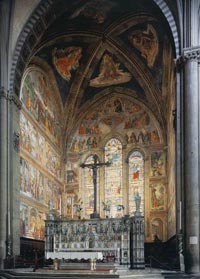 The Tornabuoni Chapel The Tornabuoni Chapel
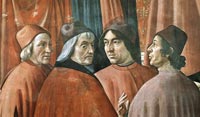 Domenico Ghirlandaio: Zachariah in the Temple [detail]: Marsilio Ficino, Cristoforo Landino, Angelo Poliziano and Demetrios Chalkondyles Domenico Ghirlandaio: Zachariah in the Temple [detail]: Marsilio Ficino, Cristoforo Landino, Angelo Poliziano and Demetrios Chalkondyles
|
|
|
|
| Filippo Strozzi Chapel
|
|
Filippino Lippi, St Philip Driving the Dragon from the Temple of Hieropolis (detail), Filippo Strozzi Chapel
|
The Filippo Strozzi Chapel is situated on the right side of the main altar. The Strozzi Chapel was the place where the first tale of the Decamerone by Giovanni Boccaccio began, when seven ladies decided to leave the town, and flee from the Black Plague to the countryside. The series of frescoes from Filippino Lippi depict the life of Philip the Apostle and James the Apostle. They were completed in 1502. On the right wall is the fresco St Philip Driving the Dragon from the Temple of Hieropolis and in the lunette above it, the Crucifixion of St Philip. On the left wall is the fresco St John the Evangelist Resuscitating Druisana and in the lunette above it The Torture of St John the Evangelist. Adam, Noah, Abraham and Jacob are represented on the ribbed vault. Behind the altar is the tomb of Filippo Strozzi with a sculpture by Benedetto da Maiano (1441).
The bronze crucifix on the main altar is by Giambologna (16th century). The choir (or the Cappella Tornabuoni) contains another series of famous frescoes, by Domenico Ghirlandaio and his apprentice the young Michelangelo (1485–1490). They represent themes from the life of the Virgin and John the Baptist, situated in Florence of the late 15th century. Several members of important Florentine families were portrayed on these frescoes. The vaults are covered with paintings of the Evangelists. On the back wall are the paintings Saint Dominic burns the Heretical Books and Saint Peter's Martyrdom, the Annunciation, and Saint John goes into the Desert.
The stained-glass windows were made in 1492 by the Florentine artist Alessandro Agolanti, known also as il Bidello, based on cartoons by Ghirlandaio.
|
|
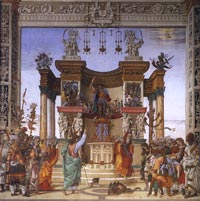 St Philip Driving the Dragon from St Philip Driving the Dragon from
the Temple of Hieropolis (detail)
|
Gondi Chapel
|
This chapel, designed by Giuliano da Sangallo, is situated on the left side of the main altar and dates from the end of the 13th century. Here, on the back wall, is the famous wooden Crucifix by Brunelleschi, one of his very few sculptures. The legend goes that he was so disgusted by the "primitive" Crucifix of Donatello in the Santa Croce church, that he made this one. The vault contains fragments of frescoes by 13th-century Greek painters. The polychrome marble decoration was applied by Giuliano da Sangallo (ca.1503). The stained-glass window is recent and dates from the 20th century.
|
Cappella Strozzi di Mantova
|
|
|
The Cappella Strozzi di Mantova is situated at the end of the left transept. The frescoes were commissioned by Tommaso Strozzi, an ancestor of Filippo Strozzi, to Nardo di Cione (1350–1357). The frescoes are inspired by Dante's Divine Comedy: Last Judgment (on the back wall; including a portrait of Dante), Hell (on the right wall) and Paradise (on the left wall). The main altarpiece of The Redeemer with the Madonna and Saints was done by his brother Andrea di Cione, better kwown as Orcagna. The large stained-glass window on the back was made from a cartoon by the brothers Andrea and Nardo di Cione.
|
Della Pura Chapel
|
|
|
The Della Pura Chapel is situated north of the old cemetery. It dates from 1474 and was constructed with Renaissance columns. It was restored in 1841 by Baccani. On the left side there is a lunette with a 14th century fresco Madonna and Child and St. Catherine. There is a wooden crucifix by Baccio da Montelupo (1501) on the front altar.
|
Rucellai Chapel
|
|
|
The Rucellai Chapel, at the end of the right aisle, dates from the 14th century. It houses, besides the tomb of Paolo Rucellai (15th century) and the marble statue of the Madonna and the Child by Nino Pisano, several art treasures such as remains of frescoes by the Maestro di Santa Cecilia (end 13th - beginning 14th century). The panel on the left wall, the Martyrdom of Saint Catherine, was painted by Giuliano Bugiardini (with possibly assistance by Michelangelo). The bronze tomb, in the centre of the floor, was made by Ghiberti in 1425.[3]
|
Bardi Chapel
|
|
|
The Bardi Chapel, the second chapel on the right of the apse, was founded by Riccardo Bardi and dates from early 14th century. The high-relief on a pillar on the right depicts Saint Gregory blessing Riccardo Bardi. The walls show us some early 14th century frescoes attributed to Spinello Aretino. The Madonna del Rosario on the altar is by Giorgio Vasari (1568).
|
Sacristy
|
|
|
The sacristy, at the end of the left aisle, was built as the Chapel of the Annunciation by the Cavalcanti family in 1380. Now it houses again, after a period of fourteen years of cleaning and renovation, the enormous painted Crucifix with the Madonna and John the Evangelist, an early work by Giotto. He had rediscovered the ideal proportions for the human body, as established by the Roman architect Vitruvius (1st century AD, see also : Vitruvian Man). The sacristy is also embellished by a glazed terra cotta and a marble font, masterpieces by Giovanni della Robbia (1498). The cupboards were designed by Bernardo Buontalenti in 1593. The paintings on the wall are ascribed to Giorgio Vasari and some other contemporary Florentine painters. The large Gothic window with three mullions at the back wall dates from 1386 and was based on cartoons by Niccolò di Pietro Gerini.
|
|
|
|
The Green Cloister
|
|
Green Cloister, Paolo Uccello, The Expulsion from the Garden of Eden
|
Paolo Uccello (1397-1475) was a leading figure in establishing the Renaissance in Florence. He was a painter and a mathematician who was notable for his pioneering work on visual perspective in art. Paolo worked in the Late Gothic tradition, and emphasized colour and pageantry rather than the Classical realism that other artists were pioneering. In 1424 he painted episodes of the Creation and expulsion for the Green Cloister (Chiostro Verde) of Santa Maria Novella in Florence (now badly damaged), proving his artistic maturity.
Uccello's earliest known paintings, representing the creation of the animals and the creation of man, are part of a large outdoor fresco series in monochrome of Old Testament scenes in the Green Cloister of S. Maria Novella, Florence. The figures have a curvilinear rhythm and sculptural strength, and they are set in a decorative yet naturalistic environment of foliage withanimals, reflecting Ghiberti's influence and very like his Creation panel in the Gates of Paradise of the Florentine Baptistery. As the gates were designed in 1425 or later, Uccello's frescoes are usually thought to have been executed after his return fromVenice , but they may date from just before he went there and reflect other designs by Ghiberti, since a small copy of Uccello's lost St. Peter mosaic in Venice (1425) already seems to show his more mature Renaissance style.
Giotto used tonality to create form. Taddeo Gaddi in his nocturnal scene in the Baroncelli Chapel demonstrated how light could be used to create drama. Paolo Uccello, a hundred years later, experimented with the dramatic effect of light in some of his almost-monochrome frescoes. He did a number of these in terra verde or "green earth", enlivening his compositions with touches of vermilion. The terra verde (meaning green earth) technique is the use of green and brown earthy tones. The best known example of this technique is his equestrian portrait of John Hawkwood on the wall of Florence Cathedral.
The influence of Masaccio is seen in Uccello's scenes from the life of Noah.
|
| The Spanish Chapel
|
In the second half of the 14th century, Andrea di Bonaiuto painted the wonderful frescos for the adjacent Spanish Chapel, in which the picture of the Church of the Triumph of the Faith closely resembled Arnolfo di Cambio's design for the cathedral, Santa Maria del Fiore. The spatial integrity of the building is already implicit in Arnolfo's plan of 1294. but the dome of the fresco model is augmented by Brunelleschi's octagonal drum that carries the dome. Another example of Dominican theology is Bonaiuto's fresco cycle showing Thomas Aquinas dominating the allegorical figures of all the liberal arts and the sciences of the theological cursus.
|
|
The Spanish Chapel, Cappellone degli Spagnoli , fresco by Andrea di Bonaiuto
|
The Spanish Chapel (or Cappellone degli Spagnoli) is the former chapterhouse of the monastery. It is situated at the north side of the green Cloister (Chiostro Verde). It was commissioned by Buonamico (Mico) Guidalotti as his funerary chapel. Construction started c. 1343 and was finished in 1355. The Guidalotti chapel was later called "Spanish Chapel", because Cosimo I assigned it to Eleonora of Toledo and her Spanish retinue. The Spanish Chapel contains a smaller Chapel of the Most Holy Sacrament. The Spanish Chapel was decorated from 1365 to 1367 by Andrea di Bonaiuto, also known as Andrea da Firenze. The large fresco on the right wall depicts the Allegory of the Active and Triumphant Church and of the Dominican order. It is especially interesting because in the background it shows a large pink building that may provide some insight into the original designs for the Duomo of Florence by Arnolfo di Cambio (before Brunelleschi's dome was built), although this interpretation is fantastical as the Duomo was never intended to be pink, nor to have the belltower at its back side. This fresco also contains portraits of pope Benedict IX, cardinal Friar Niccolò Albertini, count Guido di Poppi, Arnolfo di Cambio and the poet Petrarch. The frescoes on the other walls represent scenes from the lives of Christ and Saint Peter on the entry wall (mostly ruined due to the later installation of a choir), The Triumph of Saint Thomas Aquinas and the Allegory of Christian Learning on the left wall, and the large "Crucifixion with the Way to Calvalry and the Descent into Limbo" on the archway of the altar wall. The four-part vault contains scenes of Christ's resurrection, the navicella, the ascension, and Pentecost. The five-panelled Gothic polyptych that was probably originally made for the chapel's altar, depicting the Madonna Enthroned With and Child and Four Saints by Bernardo Daddi dates from 1344 and is currently on display in a small museum area accessed through glass doors from the far end of the cloister. Together, the complex iconography of the ceiling vault, walls, and altar combine to communicate the message of Dominicans as guides to salvation.
|
The Pharmacy of Santa Maria Novella is in Via della Scala, in the complex of Santa Maria Novella. It is no more a pharmacy, but a perfumery that still nowadays continues its commercial activity being open to the public. It is in a very monumental environment, with decorations and ancient pieces of furniture going back to various ages. It keeps also a valuable collections of scientific material, like thermometers, mortars, balances, measures, etc., besides to valuable pharmacy-pots from XV to XVIII century. It is documented that since the 1381 the Dominicans of Santa Maria Novella sold the roses water like a disinfectant, used especially during the epidemic periods. The friars cultivated th medicinal plants (the "Semplici" from the name of the Semplici Garden) in an adjacent garden, distilled herbs and flowers, prepared essences, elixirs, creams, balsams. In XVIII century its products were exported as far as Indies and China. In spite of the XVII-century abolitions, it remained working thanks to Fra Damiano Bensi and in 1866 was rented to the nephew Cesare Augusto Stefani, whose heirs manage still nowadays the activity. Today it is believed the most ancient pharmacy in all Europe, working since near 4 century, as well as one of the most ancient commercial stores in absolute.
|
| |
|
|
|
|
| |
|
Grotere kaart weergeven |
| |
Address | Piazza di Santa Maria Novella, 50123 Firenze (FI)
Opening hours | Open weekdays 9 a.m. - 5.30 p.m.
Fridays 11 a.m. - 5.30 p.m.
Saturdays 9 a.m. - 5 p.m.
Sundays and religious holidays 1 p.m. - 5 p.m.
The museum, adjacent to the church, is managed by the city of Florence and foresees a separate admission fee. The ticket includes a visit to the Green Cloister with frescoes by Paolo Uccello with scenes from the Old Testament and, being outside, are in bad shape but can still be admired.
The Chapter House, called the Cappellone degli Spagnoli or Spanish Chapel ever since it was used by the courtiers of Eleanor of Toledo, wife of Cosimo I. The chapel features frescoes by Andrea di Bonaiuto depicting Jesus Christ's passion, death and resurrection on the front wall as you enter. To the right, in the Triumph of the Doctrine, the dogs of God (a pun on the word Dominican - domini canes) are sent to round up lost sheep into the fold of the church. To the left, another fresco the Triumph of the Catholic Doctrine while the entrance wall frescoes depict stories of the life of St. Peter Martyr.
The tour ends in the ancient refectory where precious liturgical objects belonging to the church's sacristy are on display as well as a few recovered synopses from Orcagna's frescoes in the Tornabuoni chapel.

Santa Maria Novella | Opera per Santa Maria Novella | Guide to all the works of art
The Crucifix painted by Giotto, the wooden Crucifix sculpted by Brunelleschi and Masaccio’s Holy Trinity would suffice in themselves to establish the glory of the Church of Santa Maria Novella, and bear witness to the highest values of Western Christian civilization. However, the reality is somewhat otherwise since the church boasts many other works of art both in painting and sculpture and architecture, as evidenced by the beautiful facade designed by Leon Battista Alberti.
It is impossible to confine the breadth of works of art in this wonderful building within a specified art-historical period. Here the sense and weight of art constitute an extraordinary anthology, a wonderful overview not merely artistic, but also theological and philosophical, over the course of almost six centuries since its beginning. It is a story that was, and still remains, especially rich in facts, ideas and content, the receipt of which well-educated and well-prepared visitors are able to identify with a keen critical sense and with subtle intuition the charm and value of what was achieved here.
Santa Maria Novella | Interactive map
Francesca Flores D'Arcais, Giotto, Abbeville Press; 1st edition (October 1, 1995)
Ciatti, Marco / Seidel, Max (Hg.): Giotto. The Crucifix in Santa Maria Novella. München: Deutscher Kunstverlag 2004. Abb. 4° Br.
Firenze | Churches, cathedrals, basilicas and monasteries of Florence
Art in Tuscany | Domenico Ghirlandaio | The Tornabuoni Chapel
Walking in Tuscany | Florence | Santa Maria Novella

[0] Foto di Miguel Hermoso Cuesta, licenziato in base ai termini della licenza Creative Commons Attribuzione 4.0 Unported.
[1] Foto , licenziato in base ai termini della licenza Creative Commons Attribuzione 4.0 Unported.
Fonte: Fondazione Federico Zeri, Università di Bologna | catalogo.fondazionezeri.unibo.it
[2] At the north end of the transept of Santa Maria Novella two brothers who were heads of a very large and active workshop, Andrea di Cione (known as Orcagna) and Nardo di Cione provided the altarpiece and frescoes for the Strozzi Chapel, one of the most important decorative programs of the time.
Dominican commitment to orthodoxy, order, and the institutional church is evident on the left wall of the chapel where a Paradise shows the elect arranged row upon row, around and beneath the figures of the enthroned Divinity and the Virgin. Both figures are crowned; the figure of God even holds a sceptre. In this configuration the Virgin - or metaphorically Maria Ecclesia (the Church) - shares unmistakably the power of the Godhead on the model familiar from Roman thirteenth-century mosaics.
Nardo was brother of Andrea di Cione (called Orcagna) and of Jacopo di Cione. All attributions to Nardo are based on Ghiberti's statement that he painted some extant frescoes in the Strozzi Chapel in Sta Maria Novella, Florence.
[3] Rucellai family | While prominent in communal government and wealthy as cloth manufacturers from the late 13th century, the Rucellai did not play a part of real importance in Florentine politics, preferring, especially in the 15th century, to devote increasing time to study and the cultivated pleasures of private life. Giovanni (1403-81) built the Rucellai Palace from 1446. This was from a design by Alberti, as was another of Giovanni's commissions, the marble façade of S. Maria Novella. He was also a more perceptive patron of artists than either Cosimo or Lorenzo de' Medici. His Zibaldone (commonplace book) gives valuable insight into the reading and manner of life of the lettered merchants of the Quattrocento.
His son Bernardo (1448-1514), a trusted supporter of Lorenzo the Magnificent, wrote a history of Charles VIII's invasion of 1494-95, De bello italico, which makes precocious use of the term 'balance of power', and his grandson Giovanni (1475-1525), who entered the Church, has some reputation as a literary pioneer. He wrote free imitations of classical poems in the vernacular and one of the earliest classicizing tragedies, Rosamunda. It was Bernardo who laid out the gardens off the Via della Scala which became known as the Orti Oricellari (Rucellai Gardens). After his death his grandson Cosimo acted as host to discussions held there on philosophical, literary and political topics. Machiavelli took part in these and his Discourses were dedicated to Cosimo and to another habitué of the Orti, Zanobi Buondelmonti. Machiavelli set his dialogues in 'The art of war' there, with Cosimo as one of the protagonists.
|

Podere Santa Pia, with its wide panoramic terrace overlooking the Maremma, is the ideal place to enjoy the beauty of Tuscany and to pass a very relaxing holiday in contemplation of nature, with the advantage of tasting the most typical dishes of Tuscan cuisine and its best wines.
The extreme simplicity of Tuscan cuisine is its strongest strength, as the flavours that emerge during the cooking process are vibrant and pure. A little known fact about Tuscan cuisine is that the French learned how to cook from their Tuscan counterparts when it was imported by Catherine de' Medici into the court of Henry II. The Tuscan style of cooking is richly flavoured and wholesome. With its original kitchen and the wood burning pizza oven, Podere Santa Pia offers an upbeat atmosphere.
Close to the house is a unique private swimming pool (12 x 5 m). On the spacious terrace around the pool are sun loungers, tables, chairs.... This is also an ideal place for outdoor dining, to enjoy an apero or dinner al fresco. The views are truly stunning, with a unique view of the hills of the Tuscan Maremma and the Tyrrhenian Sea in the background.
Tuscan Holiday houses | Podere Santa Pia
|
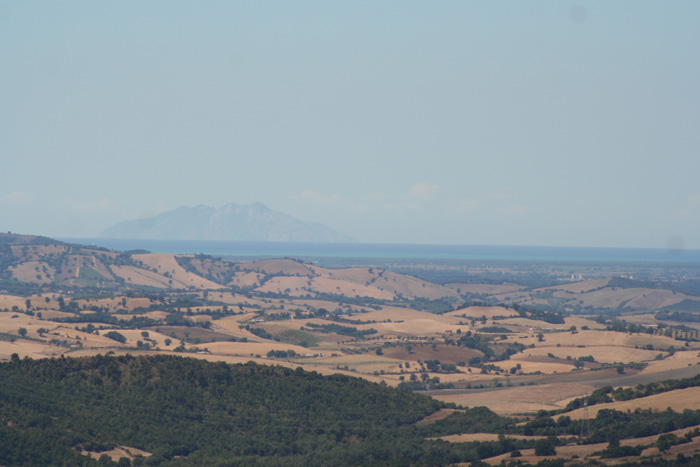 |
|
| |
|
|
|
|
|
|
|
|
|
|
Podere Santa Pia |
|
Podere Santa Pia, garden |
|
Montecristo, view from Santa Pia
|
 |
 |
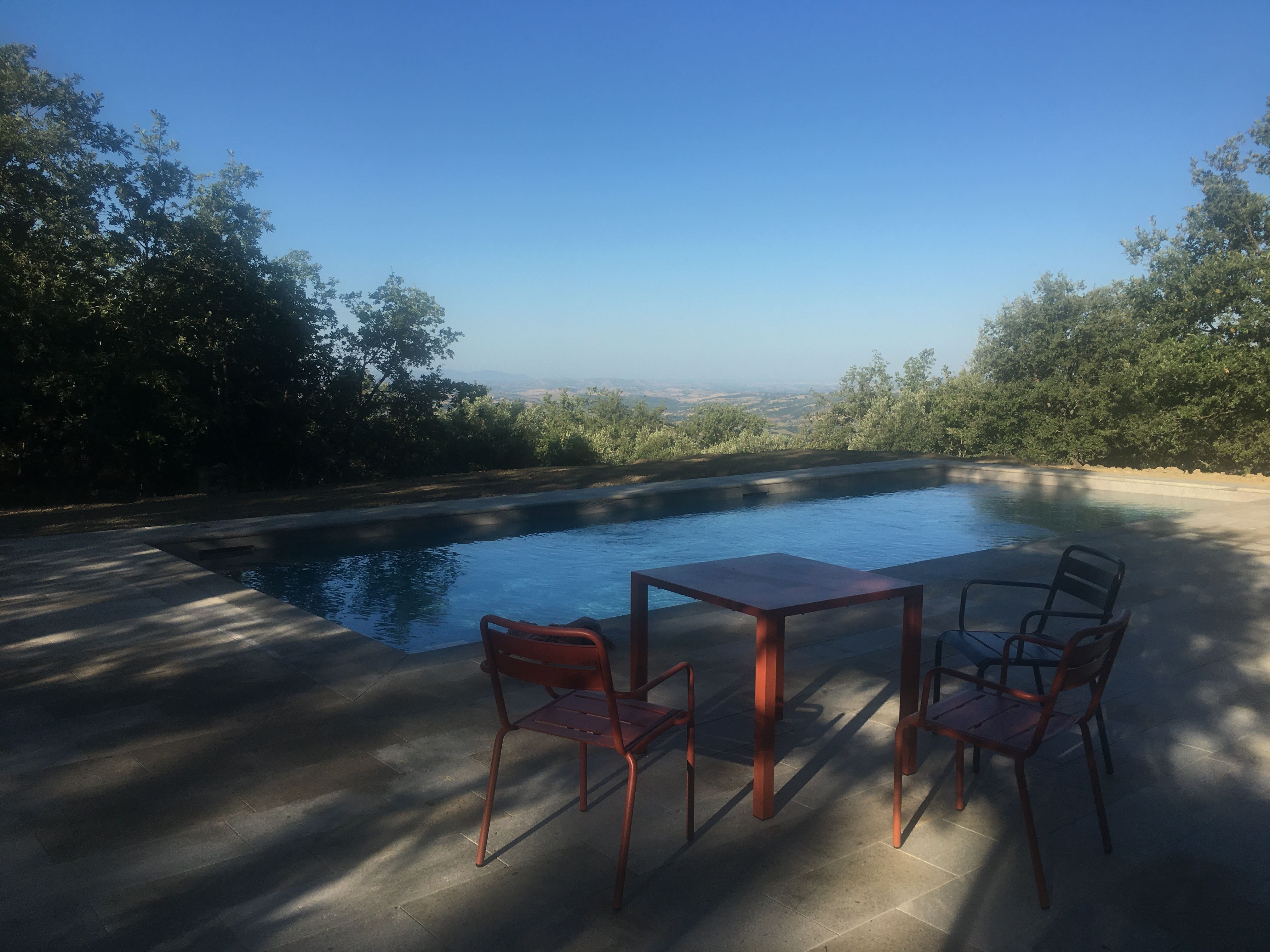 |
|
 |
Podere Santa Pia, mystic holiday home in the heart of the Tuscan Maremma
|
|
Early morning light at the private swimming pool at Podere Santa Pia
|
|
A beautiful early evening by the pool, in the resplendent Tuscan sun, time takes on a languid quality
|
| |
|
|
|
|
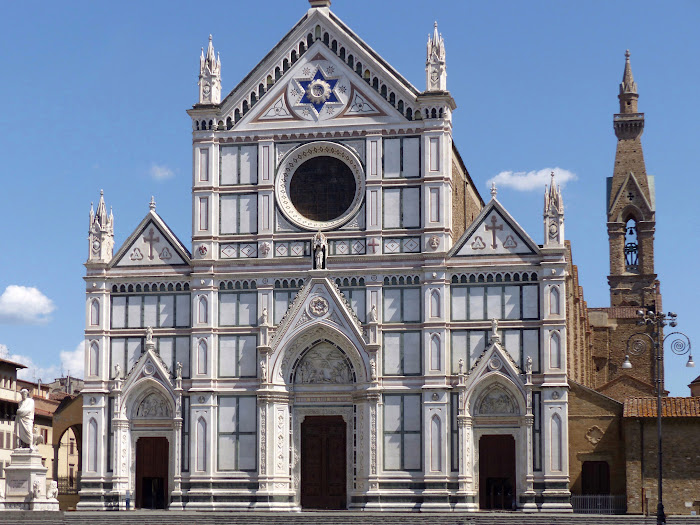 |
|
 |
|
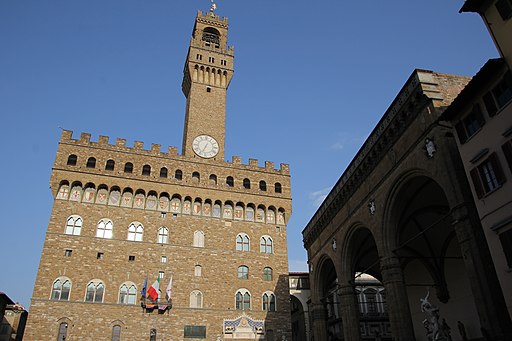 |
Firenze, Basilica di Santa Croce, facciata
|
|
Lungarno street along the Arno river, in Florence, Italy. At left, Ponte Vecchio brigde, at the centre, the Uffizi
|
|
Palazzo Vecchio, Loggia dei Lanzi, Piazza della Signoria, Firenze
|
| |
|
|
|
|
| |
Wikimedia Commons has media related to Santa Maria Novella, the Cappella Tornabuoni
|
The Piazza of Santa Maria Novella
In 1287, with a decreto of the Florentine Republic, Piazza of Santa Maria Novella was to be created and given to the Dominicans for decoro, or decorum and ornament, to the new church being built. Right away, the piazza became theater to festivals, tournaments and other contests. The two obelisks of marble from Serravezza, each one sitting atop four bronze turtles by Giambologna and topped with a Florentine lily, were the "goals" for the "Palio dei Cocchi".
On the side opposite the church, the Loggia of the San Paolo hospital was built at the beginning of the 13th century. In the second half of the 15th century, the hospital was enlarged and given the loggia with stone columns.

From Piazza del Signoria to the Mercato Centrale
The arches between each column have round glazed terracotta reliefs of saints by Andrea della Robbia. The lunette shaped relief of The Embrace between St. Dominque and St. Francis over the right portal is also by Andrea della Robbia.
Where Piazza del Duomo is Florence’s religious focus, (1) Piazza della Signoria forms its civic heart. For centuries the city was run from the (2) Palazzo Vecchio in this piazza, a rambling palace filled with spectacular salons and precious works of art.
Take in the statues beneath the 14th-century (3) Loggia dei Lanzi on the piazza’s southern flank, notably Donatello’s “Judith and Holofernes.” Then follow Via Vacchereccia from the square’s southwest corner to the (4) Mercato Nuovo at the corner with Via Por Santa Maria, a small, loggia-shaded market that dates from the 11th century.
From the market walk west to visit the (5) Palazzo Davanzati, on Via Porta Rossa on the corner of Via de’ Sassetti—it is one of Florence’s most enchanting museums. The interior preserves the appearance, furniture, and fittings of a medieval Florentine town house.
Either continue west from here, or backtrack a little to pick up one of the small alleys south off Via Porta Rossa to Via delle Terme and then Borgo Santi Apostoli. Both these streets are quieter and more appealing to explore than Via Porta Rossa.
All three streets west eventually bring you to (6) Santa Trinità in Piazza Santa Trinità, a church bypassed by most visitors. Step inside to admire the many frescoes, especially those of Domenico Ghirlandaio in the Cappella Sassetti (1482-85).
Then take Via del Parione to the west of the church, looking out for the tiny alley (first right) that takes you to Via del Purgatorio, where you should turn left to (7) Palazzo Rucellai, on Via della Vigna Nuova opposite Via del Purgatorio. The latter dates from the 1440s and is known for its restrained classical facade.
Turn right (east) down Via della Vigna Nuova to Via de’ Tornabuoni, two streets with the lion’s share of Florence’s designer stores. Either explore the smart boutiques here or turn immediately left on Via della Spada and then right on Via delle Belle Donne to Piazza Santa Maria della Novella.
The piazza is home to (8) Santa Maria della Novella, the city’s most compelling church (www.smn.it) after Santa Croce. Amid countless artistic highlights, the key treasures are Masaccio’s painting of the “La Trinità” (1427) and the fresco series in the chancel and its flanking chapels.
Follow Via dei Banchi from the east side of the piazza and take the first alley on the left, crossing Via dei Panzani and following Via del Giglio to the entrance to the (9) Cappelle Medicee in Piazza Maria Madonna degli Aldobrandini. This complex of crypts and chapels contains the tombs of many members of the Medici dynasty, but is best known for several major sculptures by Michelangelo, created to adorn the tombs of the family’s more notable members.
One block north of the chapels, off Via Del Ariento, is the (10) Mercato Centrale, or central market, a fantastic medley of color and activity, crammed with fruit, vegetables, meat, cheese, herbs, pasta, and seasonal specialties such as truffles, wild boar, and plump porcini mushrooms.
|
|
|
National Geographic | www.nationalgeographic.com/florence-walking-tour-3
Florence | Transport |
|
|
| |
|
|
|
| |
|
|
|
| |
|
|
|
| |
|
|
|
| |
|
|
|
| |
|
|
|